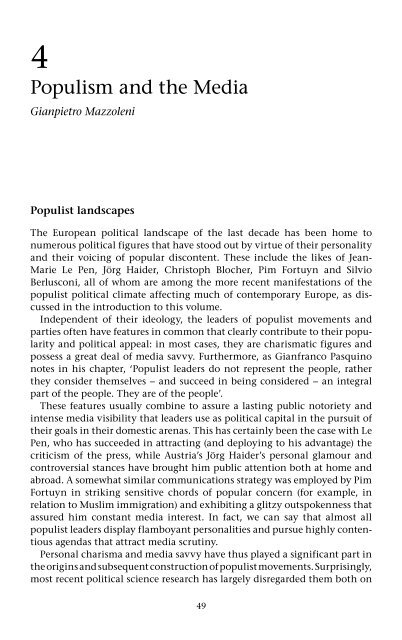Twenty-First Century Populism: The Spectre of Western European ...
Twenty-First Century Populism: The Spectre of Western European ...
Twenty-First Century Populism: The Spectre of Western European ...
You also want an ePaper? Increase the reach of your titles
YUMPU automatically turns print PDFs into web optimized ePapers that Google loves.
4<br />
<strong>Populism</strong> and the Media<br />
Gianpietro Mazzoleni<br />
Populist landscapes<br />
<strong>The</strong> <strong>European</strong> political landscape <strong>of</strong> the last decade has been home to<br />
numerous political figures that have stood out by virtue <strong>of</strong> their personality<br />
and their voicing <strong>of</strong> popular discontent. <strong>The</strong>se include the likes <strong>of</strong> Jean-<br />
Marie Le Pen, Jörg Haider, Christoph Blocher, Pim Fortuyn and Silvio<br />
Berlusconi, all <strong>of</strong> whom are among the more recent manifestations <strong>of</strong> the<br />
populist political climate affecting much <strong>of</strong> contemporary Europe, as discussed<br />
in the introduction to this volume.<br />
Independent <strong>of</strong> their ideology, the leaders <strong>of</strong> populist movements and<br />
parties <strong>of</strong>ten have features in common that clearly contribute to their popularity<br />
and political appeal: in most cases, they are charismatic figures and<br />
possess a great deal <strong>of</strong> media savvy. Furthermore, as Gianfranco Pasquino<br />
notes in his chapter, ‘Populist leaders do not represent the people, rather<br />
they consider themselves − and succeed in being considered − an integral<br />
part <strong>of</strong> the people. <strong>The</strong>y are <strong>of</strong> the people’.<br />
<strong>The</strong>se features usually combine to assure a lasting public notoriety and<br />
intense media visibility that leaders use as political capital in the pursuit <strong>of</strong><br />
their goals in their domestic arenas. This has certainly been the case with Le<br />
Pen, who has succeeded in attracting (and deploying to his advantage) the<br />
criticism <strong>of</strong> the press, while Austria’s Jörg Haider’s personal glamour and<br />
controversial stances have brought him public attention both at home and<br />
abroad. A somewhat similar communications strategy was employed by Pim<br />
Fortuyn in striking sensitive chords <strong>of</strong> popular concern (for example, in<br />
relation to Muslim immigration) and exhibiting a glitzy outspokenness that<br />
assured him constant media interest. In fact, we can say that almost all<br />
populist leaders display flamboyant personalities and pursue highly contentious<br />
agendas that attract media scrutiny.<br />
Personal charisma and media savvy have thus played a significant part in<br />
the origins and subsequent construction <strong>of</strong> populist movements. Surprisingly,<br />
most recent political science research has largely disregarded them both on<br />
49



